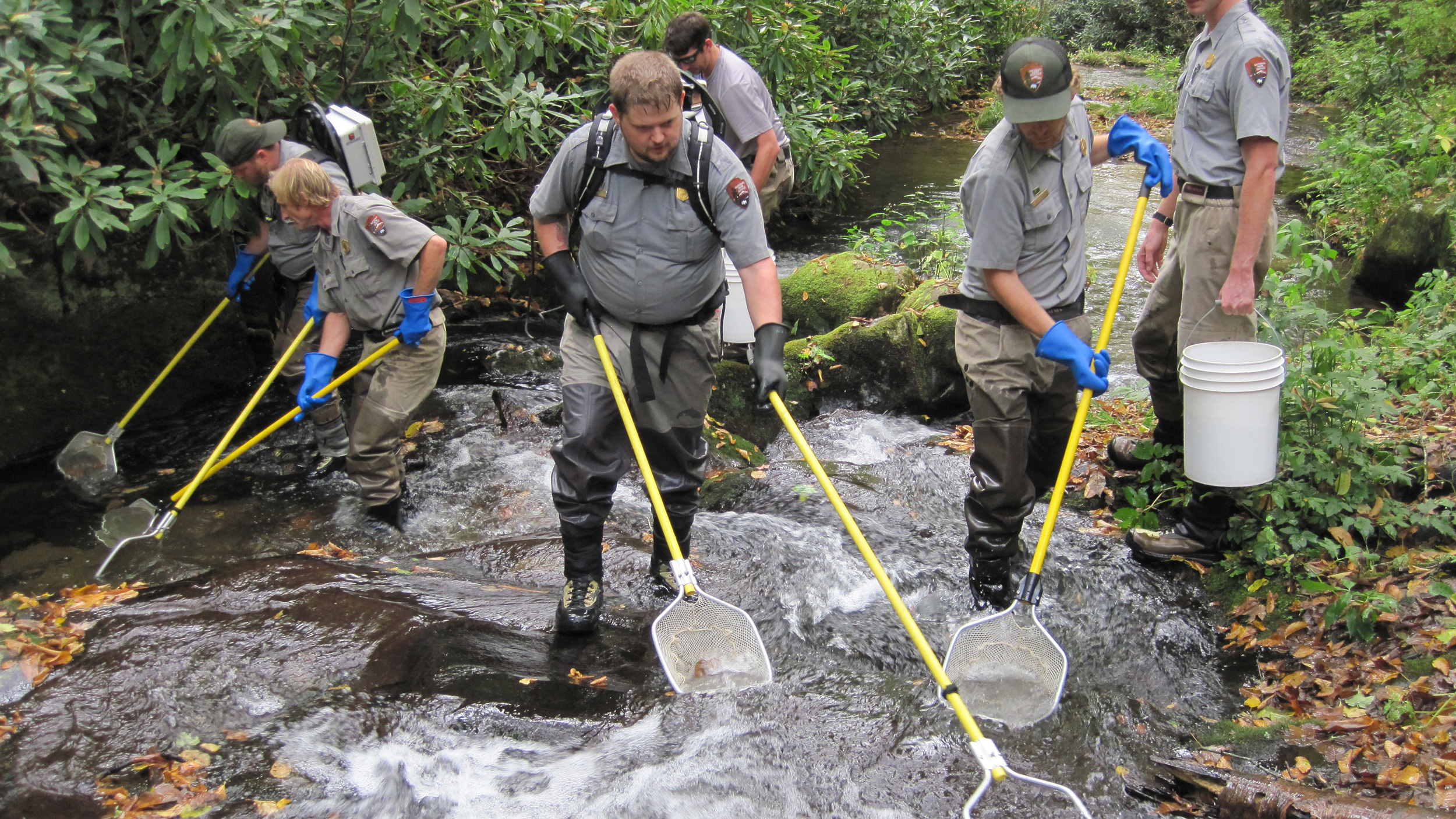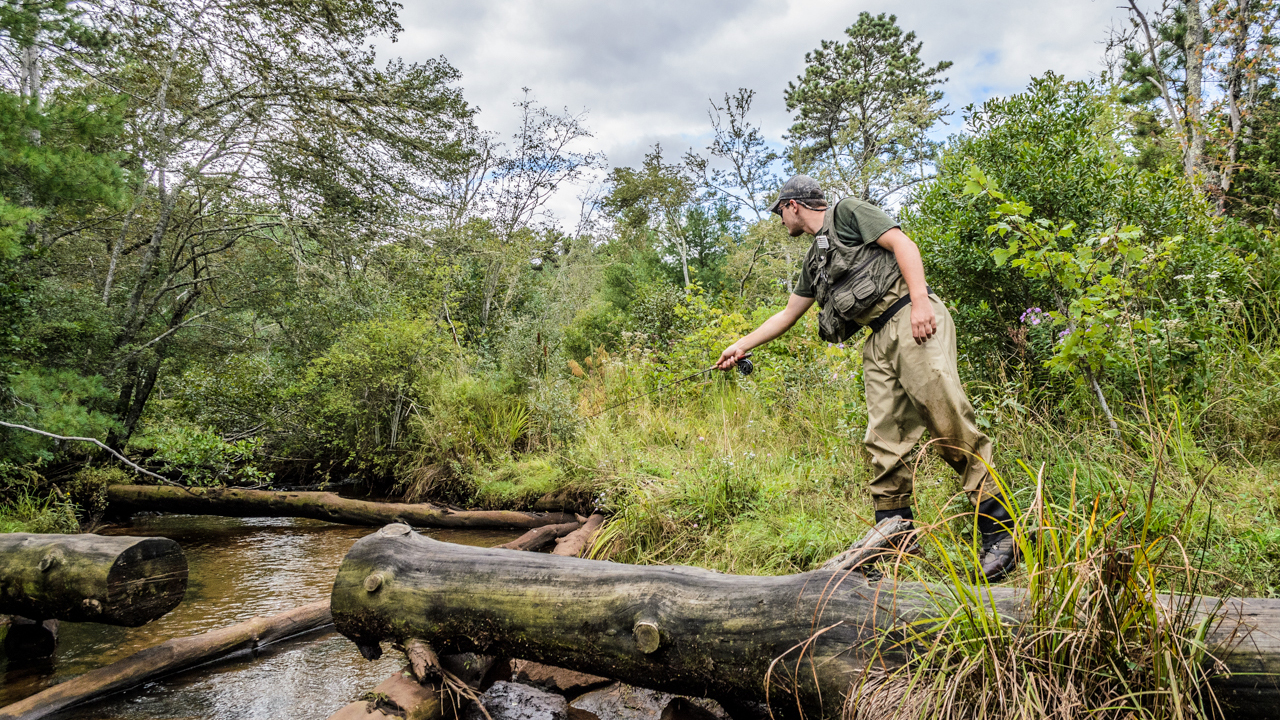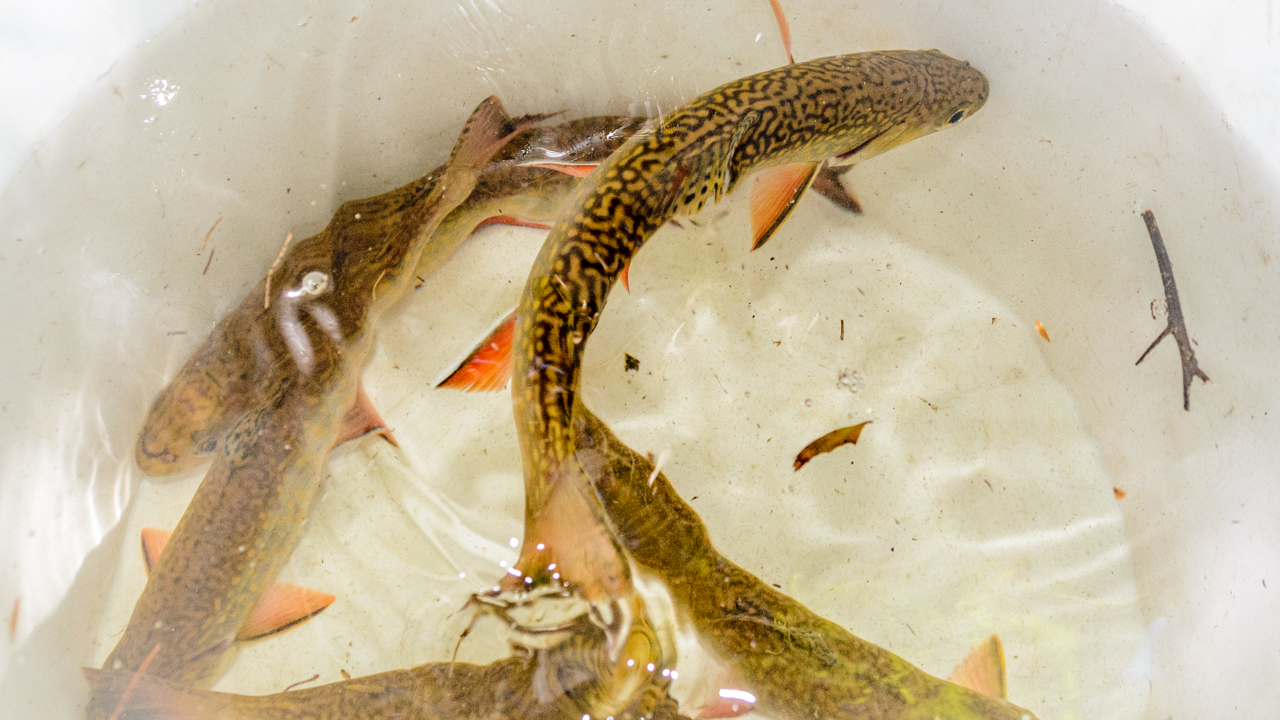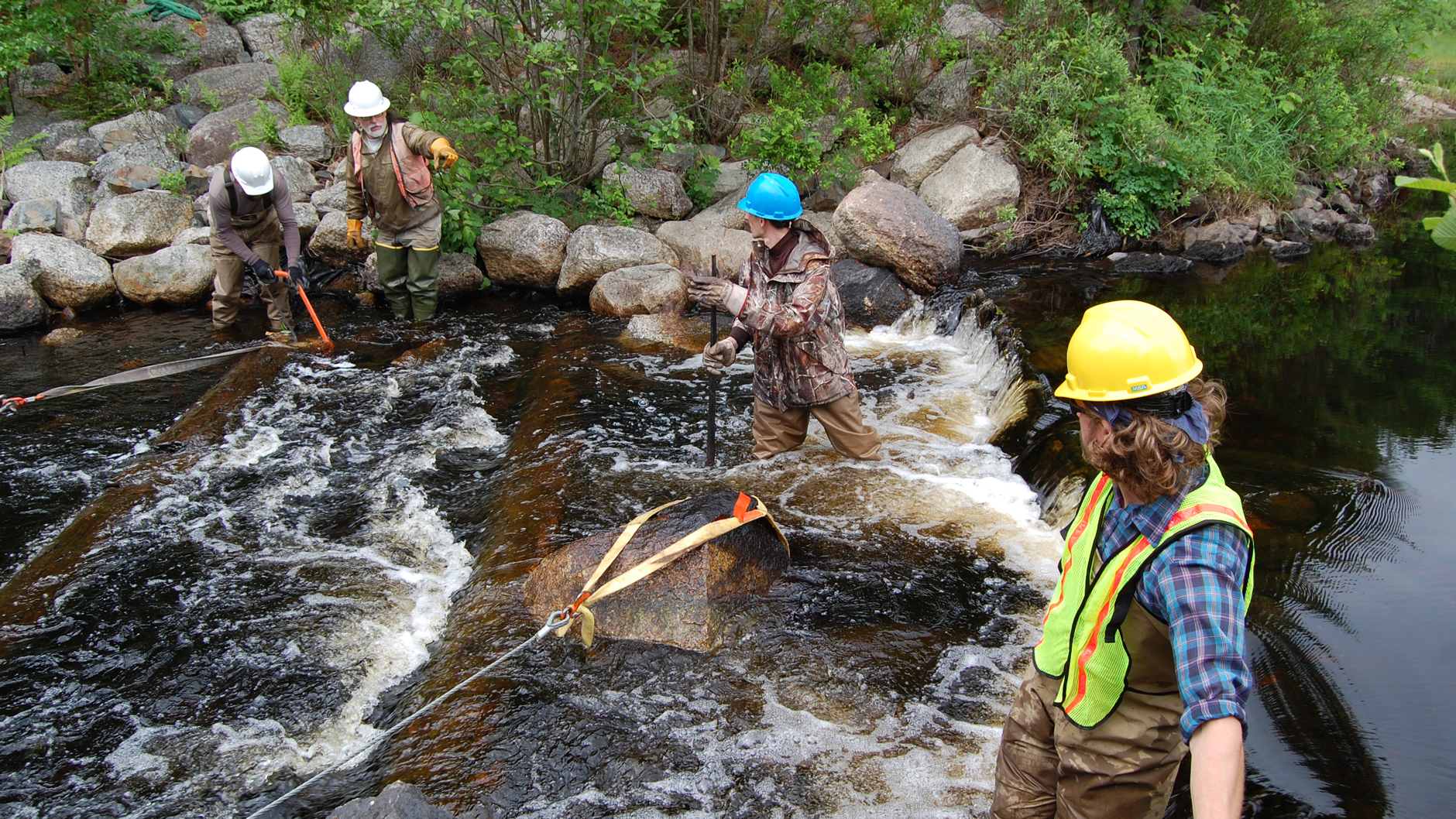The belly of the fish I was holding in a nameless rill high in Great Smoky Mountains National Park glowed with impossible shades of orange. Underfins were trimmed with ivory; chestnut flanks bore specks of ruby ringed with sapphire. Brook trout can exceed two feet in length, but at 7.7 inches this one was big for its habitat. Recovered from its recent jolt, it shot back into the icy flow.
Park biologist Matt Kulp had electro-shocked it in his search for much larger rainbow trout stocked decades earlier when “a trout was a trout” and quality was measured by weight. In the park’s headwaters Kulp and his colleagues have been shocking rainbows and tossing them below impassible falls or, in bigger water also sealed by falls, killing them with short-lived poison. That’s because brook trout belong here and rainbows, from the Pacific Northwest, don’t. So far, the natives have been restored to 27.6 miles of 11 park streams. But this older race of brook trout, unique to the southern Appalachians, has been extirpated from 95 percent of its habitat.
Everywhere in the species’ natural U.S. range, from Georgia to Maine and as far west as Iowa, there is less and less of what it needs most — cold, clean water. The brook trout’s scientific name, Salvelinus fontinalis, translates to “dweller of springs.” Brook trout in America (and even Canada) are being lost to habitat damage and alien fish.
But recovery work is underway. On the warm, windless morning of December 23, 2015 I toured Red Brook in Plymouth, Massachusetts with Steve Hurley, regional fish manager for the state Division of Fisheries and Wildlife, and Warren Winders and Geof Day of the Sea Run Brook Trout Coalition.
Where brook trout have access to the ocean they’ll take advantage of that rich environment. Reversing the growth cycle of landlocked fish, these “salters” fatten in winter, then find summer refuge from striped bass, bluefish and ospreys in freshwater. Red Brook’s salters would have been lost to cranberry culture had not passionate angler Theodore Lyman bought much of the watershed in 1870.

In the early 1990s, when Winders, Day and other advocates urged the Division of Fisheries and Wildlife to protect Red Brook’s native trout, they were told that such fish didn’t exist. When they showed them to the Division they were told that the fish were merely offspring of hatchery trout. When genetic analysis by a graduate student proved Red Brook salters were not only distinct from hatchery stock but also from other salters the Division became a believer and protector.
Salters are endangered in fact, if not by official decree; and Hurley, a biologist of the new breed, manages them accordingly. He reintroduces them to streams where they’ve been extirpated. And he oversees habitat work by the Sea Run Brook Trout Coalition and Trout Unlimited, including the planting of streamside vegetation, log insertion and restoration of pools and riffles.

Where Red Brook curls trough an ancient cranberry bog, now rife with sweetgale, blueberry, alder, scrub oak, pitch pine and bull briar, Hurley hitched his laptop to a monitor that records the presence of trout injected with tiny PIT (passive integrated transponder) tags. In the previous six days 78 fish had passed the station. Upstream we came across remains of one of four dams removed by Trout Unlimited, the Division of Fisheries and Wildlife and Trustees of Reservations.
Red Brook’s salters thrive because of this habitat work, because the land around its 4.5-mile course is protected by the Division and Trustees, and because fishing is strictly catch-and-release.

Other once-famous salter streams, some fished by U.S. presidents, haven’t been so lucky. This past fall when Hurley sampled the Santuit River on Cape Cod he found that the population had blinked out. It had, he said, succumbed to “death by a thousand cuts,” not the least of which was water withdrawal by the Willowbend Golf Course and associated development. The day before my tour of Red Brook Geof Day had encountered a maintenance crew armed with chainsaws and shrub cutters waist-deep in the Santuit, supposedly making it “safe” for herring by removing the brush and woody debris salters (and herring, too) need for shade and cover.
Landlocked brook trout, also gravely diminished, have a wider distribution. In 2006 federal and state agencies, local governments, conservation organizations, businesses, scientists and citizens formed a recovery partnership called the Eastern Brook Trout Joint Venture. Matching funds for projects are provided by the U.S. Fish and Wildlife Service. So far, 78 have been approved.
Much of the work involves connecting fragmented habitat. Water scours deep holes when it shoots through tight culverts, leaving them hanging and inaccessible to trout seeking refuge in cool headwaters during summer, a need accentuated by global warming. The Nature Conservancy assesses culverts to determine which ones impede fish and other aquatic organisms.

In 2011 Tropical Storm Irene blew out undersize culverts all across the Northeast, at least 1,000 in Vermont alone. That provided an opportunity to replace many with “stream-simulation culverts,” funded in part by the Joint Venture. These span the stream and are lined with its natural substrate. The Green Mountain National Forest had installed a few before Irene, and they survived the flood.
Brook trout recover fast from storms, but not from humans who re-engineer coldwater habitat in vain attempts to make it “flood proof.” After Irene, municipal and state highway departments in New York and New England applied their training to trout streams — that is, they operated on them as if they were highways. They razed riparian vegetation, bulldozed bottoms flat, widened channels, excised pools, riffles and meanders, gouged out gravel and woody debris, then sealed off floodplains by dumping the “spoil,” as they called it, along banks. Hundreds of trout streams were converted to straight, lifeless sluiceways that endangered people downstream by blasting water onto their property. On Massachusetts’ Chickley River, for example, the Town of Hawley unlawfully gutterized 4.5 miles of the state’s best brook-trout habitat.

Was anything learned from the hysterical, counterproductive response to Irene? Maybe. Vermont fisheries manager Rich Kirn told me this: “We’ve changed a lot of regulations and developed a rivers training program for state and municipal transportation folks to provide info on how streams work.” In Massachusetts an out-of-court settlement required Hawley and its contractor to partially repair the Chickley River (full repair is impossible). The contractor agreed to pay $225,000, the town $184,000.
In Appalachia hundreds of miles of fragmented brook-trout water is being reconnected by in-stream treatment of acid-mine runoff. With Trout Unlimited activist Bill Thorne of Reedsville, West Virginia I hiked along a recovering section of the state’s Morgan Run to a “doser” — a green silo from which crushed limestone is pulled down by a wheel powered by the flow and therefore dispensed at the appropriate rate. In once-dead Deckers Creek, which flows by Thorne’s house, brook trout now prosper thanks to dosers, limestone channels and settling ponds.
Nowhere has recovery been more successful than on Maine’s Machias and East Machias River systems. Project Share — a coalition of state and federal agencies, landowners, The Nature Conservancy and other NGOs — has saved and restored brook trout by protecting 122,288 watershed acres through purchase and easement. In addition Project Share has restored much of the large woody debris removed during log-drive days, replaced hundreds of hanging culverts and breached dozens of remnant dams.

America is starting to understand that fish are wildlife, too. But we need more of what Aldo Leopold called “an ecological conscience.” Most states still defile native-trout water with hatchery-produced aliens, including “Frankenfish” concocted by crossing brook trout with lake trout, brown trout with brook trout, and by culturing pigment-deprived mutants called “golden rainbows” and “palomino trout.”
The dweller of springs is an indicator of land and water health, and its recovery isn’t about one fish. Healthy brook-trout habitat sustains 68 other native species in desperate need of protection. Brook trout are no less important to the East than, say, elk to the West — not because they are beautiful (though they are), not because they are exquisite table fare (though they are), not because they are superb fighters (though they are), not because they are anything. Only because they are.




Great article, I’m a strong advocate of brook trout preservation. Here in south Jersey there is only one stream left that supports these beautiful native fish. If you google “Saving Mason’s Run” you can read about our efforts and my book on the subject.
So nice to hear good news about animals making comebacks.I’ve taken some classes on aquaculture technology here in Hillsborough County Florida and at one point was going to work at a redfish hatchery so I have an idea of what goes on w/enhancing wild populations but it would be great if that would never be needed w/these brook trout.I do aquarium maintenance and have 5 aquarium demonstration videos on youtube.My account name is aquamanerik and I’ve been keeping fish for over 40 years counting catching minnows and sunfish in OH where I’m from originally and keeping them in buckets for a couple days before letting them loose.
Thank You for all the info about brook trout & all the work being done on behalf of the fish. Every animal & every part is so very important. Thank you. I do already receive your emails so, just want to make certain i don’t get 2 copies…..
The Poestenkill creek in Rensselear County in New York State has sustained devastating bulldozing after Irene. Where is trout Unlimited and why haven’t they addressed this destruction by now.
Wow- wonderful story never knew these kinds of trout existed.
Great article.
Discoveredt his beautiful fish 65 years ago around Wright’s Lake in the Sierra Nevada. They too were threatened by plants of rainbows and browns. A beautiful place with wonderful fish. Any effort to protect them is worthy of the effort.
In New Jersey we are spending a lot of TU efforts on the dam removal on our major rivers. This is understandable, but it has taken the empasis off restoring feeder creeks that are the bed rock for Easteren Brook Trout restorations. Case in point TU was in the process of restoring Brook Trout habitat in Kurtenbach’s Brook with both dollars and plans in place, but it all came to naught as dam removal on the Moscanetcong River took over the priority. TU needs to get back to restoring Brook Trout habitat in NJ.